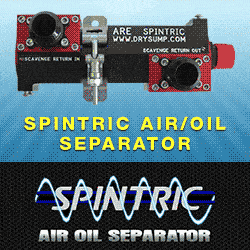Dry Sump Instructions
Drive Systems
Dry Sump oil pumps, whether scavenge only pumps, or 3-5 stage pumps with pressure stage, are generally driven off the crankshaft, either by special ATI Dampers built for ARE with pump drives incorporated or with drive mandrel/Pulley assemblies bolted to front of c/s Damper/Pulley.
NOTE: From index on www.DrySump.com Home Page- Go to "Drives" and "Drive Gallery" for photos and information, located in index on left.
Scavenge Only Systems
Our Scavenge only systems as used on Chevrolet LS series Engines- ARE Stage 1 systems, are typically driven with serpentine belt drives, using our 8005 or 8007 (Y or F) body dampers, and 3020YM or 3020FM pump mount/tensioner assemblies.
NOTE: These systems use the stock internal pump to supply pressure
Stage II & III Pumps w/pressure stage
On our Stage II, III or IV systems we always use a HTD (High Torque Drive) Round tooth metric, or Gilmer (Square tooth) drive assembly.
Generally we design the drive system to run the pump at between 50-65% of crankshaft speed.
ARE LS Series Dry Sump Systems
The ARE "Direct to Block" mounting system is specially designed to allow both Y body corvette and F body systems to be driven with out HTD/ATI drive assembly. the belt tension is pre-determined and only needs to be adjusted slightly as block variations dictate, by using 2 precision flat washers between pump mount bracket, and black/ARE triangular plate. The belt should be "Taught" but never tight. Conversely- belt should not have too much slack. the slack side of belt should be able to twist approx. 45 DEG from flat.
This same type belt tensioning system is used to "fine tune" belt tension on our side mount pumps only with 4 washers or equal thickness under each pump mount "Leg."
Checking Oil Level in Tank
On ARE Dry Sump Tanks- oil level in operation should be at or just below slotted or screened baffle at upper portion of tank. after running remove cap and look at oil level through cap/filler hole. (See instructions on LS7 Install Instructions #7-8 Click Here)
NOTE: Make sure engine is run prior to checking as oil can find it's way back to pan via gravity, giving a wrong tank level reading. (within minutes)
Adjusting Pressure on Dry Sump Pumps
On our 3, 4 stage, and up DrySump Pumps WITH a pressure stage ( NOT scavenge only) pressure can be adjusted. On the rear, BOTTOM ( INLET SIDE) of the pump there is a hex nut and threaded adjusting screw pointing up ( vertically ) Loosen the hex nut, and with an allen wrench, screw the adjuster IN ( CLOCKWISE) to increase Pressure, and COUNTER CLOCKWISE to back it off ( reduce pressure) . Every engine / Pump is slightly different, but usually one turn will increase or decrease pressure by 20-30 PSI Then tighten the nut back up.
Draining the oil in a Dry Sump System
To change oil in a Dry Sump System, the oil should first be still warm from running. Dry sumps differ from standard wet sump systems in that the majority of the engines oil is stored in the Dry Sump tank. However, there will still be oil in the pan, lines and filter.
1) ARE dry sump oil tanks have a threaded "O" ring plug in the very bottom of the tank, under the cone shaped bottom. Remove this plug to drain the majority of the oil. If you can not get to the bottom drain plug, the oil can be ( mostly) drained by un screwing the line hose end that is connected to the oil supply fitting on rear bottom of the dry sump pump pressure stage. (ARE pumps) or in the case of scavenge only systems, from the fitting in the pan that supplies the internal oil pump. This line can then be allowed to hang down below the tank bottom and drain. Most of the oil will be syphoned out, as although the fitting is on the lower side of the tank, ARE tanks have an internal tube going to the bottom.
2) ARE dry sumps have integral screen filters built into the scavenge fittings in the pan, which help protect the scavenge stages on the dry sump pump from any large particles in the oil. These should be removed to check the screens for debris. At the same time, this will allow the oil that remains in the engine and pan to drain.
3) The rest of the lines and oil cooler can be drained the same way.
4) The spin on oil filter will also be changed at this time, and lines drained if needed. . The new oil filter should be filled with your new oil before installing. This allows the engine to get pressurized oil sooner, without having to fill the filter too.
Keep in mind that if this is a normal maintenance or "after every race" oil change, and there is no debris in the oil, or reason to think there might be, you do not have to drain all the lines unless you want to. The tank, pan, filter and cooler should evacuate the majority of the oil, and if relatively clean will merge fine with the new oil.
Note: this is totally a matter of choice and not a recommendation
After the oil change, follow the normal "tank filling and oil level" instructions.








